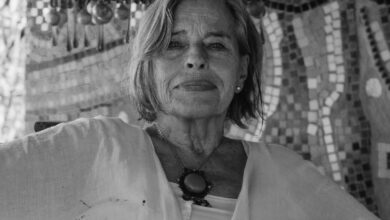Yousra Shaher’s furniture is not about aesthetics. “It’s mainly about the concept, the inspiration and what this concept means to me,” she says. An architect by training and a designer by profession, she talked to Al-Masry Al-Youm during a showcase of her work as a young designer at Cairo’s fair grounds.
As we sat sipping tea, interrupted at intervals by people inquiring about her eye-catching coffee tables, she told me how her passion for architecture was inspired by the design of Sydney Opera House and the drive of the architect. “I wanted to get a degree in architecture, and I did. I worked hard. To create and to learn was the priority for me, much more important than the opinions of my professors.”
The coffee tables were from her mashrabeya collection, she calls them “mash tables”. Mashrabeya is an Arabic term for the projecting oriel windows enclosed with carved wood lattice work found on the upper floors of traditional Egyptian houses.
As we sat, fellow designers stopped to ask about her technique. Shaher became almost breathless explaining her creations. At 28, she said she felt lucky to be exhibiting her work and getting to talk publicly about her passion.
Her mashrabeya concept is simple. When the mashrabeya is dismantled, each piece is unique. Her design concept lies in taking the pieces, enlarging them to scale on paper and using them to make her coffee tables.
“Simple concepts, simple details can yield to beauty,” she added. “It doesn’t have to be complicated to be beautiful. You have to give yourself time to nurture the simplicity.”
The Arabesque screens have variable shapes and types of artwork; the pieces that make up the screens all have different forms and are not identical, though a casual glance may make them appear so.
Shaher uses oak and walnut wood for the coffee tables, “all solid, very good material. I try to apply different finishes like using glossy lacquer, it’s a new trend in modern design. It gives it this new touch, an up-to-date effect,” she said. “I love modern effects, because of their lines and smooth surfaces, it’s clear and uncomplicated.”
Although keen to gain a regular clientele, she refuses to tailor pieces to suit clients’ tastes. “It’s more like art, and I’m targeting a specific clientele. I can’t let people dictate to me what they want. I design my pieces, according to my ideas. And only those who understand it will love it.”
Her shift from architecture to design was gradual, and she incorporates elements from both disciplines. Architecture first engaged her, but interior design with all its detail became her passion.
“From doing some freelance interior work, I moved to design furniture and this is how I got interested in product design,” she said.
Her first product was a napkin plate. “I designed it for a competition. I looked at it and felt it was different. Designing a small product gives you a feeling of gratification as soon as it’s finished. I also had positive feedback from friends and fellow designers.”
Shaher, who believes that mental well-being, physical health and design are intimately connected, said the act of design is mainly about channeling energy. Her svelte figure and affinity for meditation and sports are a testimony to how she takes the “healthy life” seriously.
“Usually when inspiration strikes, ideas come rushing to my mind, something nags at me inside, and there’s no release until the full design is on paper.”
Although some artists are almost ritualistic in their design habits, Shaher is not although she admits to loving working in the open air. She says that having strong relationships with family and loved ones inspires balanced work, and that she relies on her husband’s encouragement.
As a young unknown designer, even with “big dreams” and an impressive portfolio for her age, it was difficult for Shaher to establish herself in Egypt, where, she says it’s all about connections so she started freelancing in Dubai where she felt she had more chances.
Where does she find her inspiration? “I always loved Islamic architecture but European designers lead the way now. Norman Foster and Zaha Hadid and Renzo Piano inspire me the most.”
Elements and colors from nature also inspire her, “the contrast between rough materials and plain surfaces. The merge of man’s work and nature, like merging rough stone, untouched by man, and marble, smoothed by him.”
Her tips to fellow designers? “An architect has to be up-to-date, always looking and searching for the newest trends. Research takes a lot of time but it’s worth it. Even classic older pieces can always be reworked and updated.”




